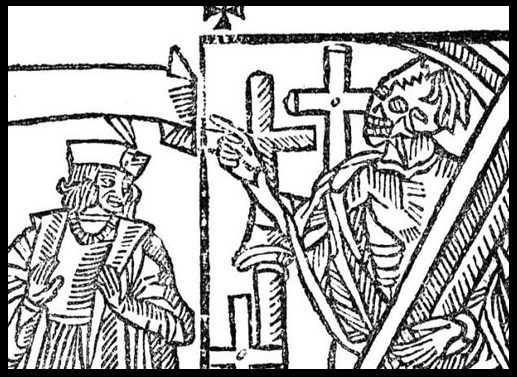
Everybody by Branden Jacobs-Jenkins
directed by KT Turner
dramaturgy by Ariana Burns
(Section of frontispiece from edition of Everyman published by John Skot c. 1530.)
Very little is known about the morality Everyman. It is a translation and adaptation of the Dutch Elckerlijc but there is no surviving record of its production history until modern day; when or where it was seen; if it was indoors or outside. Nor any description of the size and shape of the stages it used (Tydemann, p 1). But that does not mean that Everyman was never produced. “It could, of course, have been staged, though unrecorded, any number of times in the early sixteenth century, and would have been ideal for presentation as a school play” (Davidson).
Despite its missing production history, it was known to have had at least four print runs to attest to its popularity (Davidson). And has been described by modern writers as one of the best examples of a morality play (Poláčková, p 325).
Much of the first half of Everyman looks backward over Everyman’s life. The acquaintances they has made and material goods acquired. And with the coming of Death, there is a realization that none of these things will make the journey to judgment. “The things of the world are banished, in other words, as part of a gradual triumph of the things of the spirit” (Garner, p 281).
At first blush, the story of Everyman may appear to be terrifying, meeting with Death, faced with mortality, and being sent to judgment. But the lesson of Everyman’s chance for redemption and a life after death makes it a tale of hope (Kaula, p 10). “The reluctant journey of Everyman’s contrite soul toward God as judge becomes a glad pilgrimage toward God as Savior” (Cunningham, p. 168).
In his “Sermon Themes and Sermon Structure in Everyman,” George Peek divided Everyman into two parts or two medieval sermons. The form of sermons then was divided into five parts: theme, protheme, introduction of theme, divisions, and subdivisions. The themes would contain the message that the orator would build from; the protheme introduced a prayer and led into proof of the theme. The introduction was a narrative which served to bring the listeners into the divisions and subdivisions which expounded on the ideas introduced in the theme (Peek, 159).
With Everyman, the messenger introduced the theme and emphasized the transitory nature of material things. God developed the Protheme: the fall of man and gave reason for the action of the play. The Introduction was the scene with Death and Everyman. The desertions were divisions. Peek detailed how the second part of the play moved from the dealing with spiritual death (averted now that Everyman is seeking salvation) to physical death (Peek, p 160).
Finally, I read an article comparing adaptations of Everyman produced in the United States which raised the question to me of what is the story of Everyman without the theme of salvation?
How can spiritual values be dramatized for a society which is generally unreligious? How can death be depicted for an audience accustomed to cosmetize death? How can abstractions such as Good Deeds be realized? How can the very familiar fable of Everyman be made fresh for a modern audience? How can the spectacle of theatre be transformed for a visually jaded audience? Earl Schreiber, p 106.
The adaptation that Schreiber commented on was Everyman Today, a 1975 adaptation of Jedermann (a 1911 German adaptation of Everyman). In it there is no redemption, no existence beyond the grave, only death. Most early moralities messaging taught that behavior while living determined where their afterlife would be spent. Jacobs-Jenkins remarked on this in Everybody, describing moralities as stories about the transience of life which means they’re really about death. And perhaps that depends on where people chose to end the story of Everyman. I’m hoping to revisit these ideas through the course of the production of Everybody.
Cunningham, John. “Comedic and Liturgical Restoration in ‘Everyman’.” Comparative Drama. Vol. 22, No. 2 (Summer 1988), pp. 162-173. www.jstor.org/stable/41153346. Dec 2, 2020.
Davidson, Clifford. “Introduction.” Everyman and Its Dutch Original, Elckerlijc. Eds: Davidson, Clifford Davidson; Martin W. Walsh; Ton J. Broos. 2007. d.lib.rochester.edu/ teams/ text/ davidson-everyman-introduction. Last accessed: Jan 9, 2021.
Garner, Jr., Stanton B. “Theatricality in ‘Mankind’ and ‘Everyman’” Studies in Philology, Vol. 84, No. 3 (Summer, 1987), pp. 272-285. University of North Carolina Press. www.jstor.org/stable/ 4174272. Last accessed: Dec 1, 2020.
Kaula, David. “Time and the Timeless in Everyman and Dr. Faustus.” College English. Vol. 22, No. 1 (Oct., 1960), pp. 9-14. National Council of Teachers of English. www.jstor.org/stable/373857. Last Accessed Dec 22, 2020.
Poláčková, Eliška. “Mutato Nomine Dicor Nunc Homulus Latin Translation of The Morality Play of Elckerlijc.” Listy filologické / Folia philologica, 2011, Vol. 134, No. 3/4, pp. 323-339. Centre for Classical Studies at the Institute of Philosophy of the Czech Academy of Sciences www.jstor.org/ stable/23468757. Dec 2, 2020.
Peek, George S. “Themes and Sermon Structure in Everyman.” The South Central Bulletin. Winter, 1980, Vol. 40, No. 4, Studies by Members of the SCMLA, pp. 159-160. The Johns Hopkins University Press on behalf of The South Central Modern Language Association. Last Accessed: Dec 1, 2020.
Schreiber, Earl G. “Everyman in America,” Comparative Drama. Summer 1975, Vol. 9, No. 2. pp. 99-115. www.jstor.org/stable/41152663. Last Accessed: Dec 1, 2020.
Tydemann, W. English Medieval Theatre. 1400-1500. Routledge & Kegan Paul. (London) 1986.